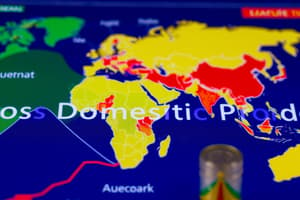Podcast
Questions and Answers
What characterizes the tertiary sector of the economy?
What characterizes the tertiary sector of the economy?
- It transforms raw materials into manufactured goods.
- It primarily consists of agricultural activities.
- It focuses on providing services to consumers. (correct)
- It involves the extraction of raw materials.
Which of the following is an example of the secondary sector?
Which of the following is an example of the secondary sector?
- Fishing
- Farming
- Glass production (correct)
- Banking
Which sectors are most heavily employed in developing countries?
Which sectors are most heavily employed in developing countries?
- Tertiary and secondary sectors
- Only the tertiary sector
- Tertiary and primary sectors
- Primary and secondary sectors (correct)
What is a primary characteristic of deindustrialization?
What is a primary characteristic of deindustrialization?
What typically characterizes developed countries compared to developing countries?
What typically characterizes developed countries compared to developing countries?
What is a key feature of the primary sector?
What is a key feature of the primary sector?
What economic change can be linked to importing cheaper goods from other countries?
What economic change can be linked to importing cheaper goods from other countries?
In the context of economic sectors, what is a distinguishing feature of the private sector?
In the context of economic sectors, what is a distinguishing feature of the private sector?
Flashcards are hidden until you start studying
Study Notes
Business Classification and Economic Sectors
- Economy Defined: Represents a country's resources, wealth, and their production, distribution, and consumption of goods and services.
- Importance of Economy: A balanced economy is crucial for maintaining stability; it can rise or fall based on various factors.
Three Economic Sectors
- Primary Sector:
- Involves the extraction of raw materials from the Earth.
- Examples: Farming, fishing, gas, diamonds, gold mining.
- Secondary Sector:
- Transforms raw materials from the primary sector into manufactured goods.
- Known as the production sector; examples include construction, refining, glass production, chemical and energy industries.
- Tertiary Sector:
- Focuses on providing services to consumers.
- Examples include retail, banking, insurance, and repair services.
Interdependence of Sectors
- All three sectors rely on each other.
- Example: Oil extraction (primary) → Refining into usable products (secondary) → Distribution to consumers (tertiary).
Developed vs. Developing Economies
- Developed Countries:
- High manufacturing standards and improved living standards.
- Lower poverty rates, higher employment in the tertiary sector, and greater economic choices.
- Higher incomes and better healthcare standards.
- Developing Countries:
- Lower average incomes, poor living conditions, and lower life expectancy.
- High population growth and dependency ratios with limited education and healthcare.
- Significant employment in the primary sector and emerging manufacturing.
Country Sector Examples
- UK:
- 74% services (tertiary), 23% manufacturing (secondary), 3% extraction (primary).
- Zimbabwe:
- 40% in primary sector (extraction), 32% in secondary sector (manufacturing), 48% in tertiary sector (services).
Industrialization and Deindustrialization
- Deindustrialization:
- Shift from industrial jobs (primary/secondary) to more service-oriented jobs (tertiary).
- Example: UK importing cheaper goods from countries like China.
- Effects of Deindustrialization:
- Disadvantages: Job loss, decline of rural communities, need for environmental cleanup.
- Advantages: Reduced pollution, repurposed land for new uses, potential for tourism and wildlife habitats.
Private vs. Public Sector
- Private Sector:
- Businesses operate to meet consumer demands and maximize profits.
- Includes local shops, private companies providing goods and services.
- Public Sector:
- Government-managed services aimed at providing for public needs rather than profit.
- Examples include schools and government services that may be free for the public.
Economy Fundamentals
- Economy encompasses a nation's resources, wealth, production, distribution, and consumption of goods/services.
- A balanced economy is vital for stability, influenced by numerous factors.
Three Economic Sectors
- Primary Sector:
- Extracts raw materials from natural resources such as agriculture, fishing, and mining.
- Secondary Sector:
- Converts raw materials into finished goods, includes industries like construction and chemical manufacturing.
- Tertiary Sector:
- Provides services to consumers, examples include retail, banking, insurance, and maintenance services.
Interdependence of Sectors
- Economic sectors are interconnected; the output from one is essential for the next.
- E.g., Oil extraction (primary) leads to refining (secondary) which results in distribution (tertiary).
Developed vs. Developing Economies
- Developed Countries:
- Exhibit high standards in manufacturing and living, low poverty, significant tertiary sector employment, and better healthcare access.
- Developing Countries:
- Characterized by lower income levels, poor living conditions, high population growth, dependence on primary sector jobs, and limited access to education and healthcare.
Country Sector Examples
- UK:
- Economic structure: 74% tertiary sector, 23% secondary sector, 3% primary sector.
- Zimbabwe:
- Workforce: 40% primary sector, 32% secondary sector, 48% tertiary sector.
Industrialization and Deindustrialization
- Deindustrialization:
- Transition from manufacturing jobs towards service-oriented roles; driven by imports of cheaper goods from countries like China.
- Effects of Deindustrialization:
- Disadvantages include job losses and rural decline; advantages may involve reduced pollution and land restoration for tourism or wildlife habitats.
Private vs Public Sector
- Private Sector:
- Comprises businesses focused on consumer demand and profit maximization, including local shops and private firms.
- Public Sector:
- Managed by government, these services aim to fulfill public needs rather than generate profit; includes schools and government-operated services which are often free.
Studying That Suits You
Use AI to generate personalized quizzes and flashcards to suit your learning preferences.




